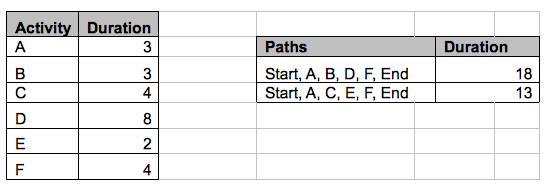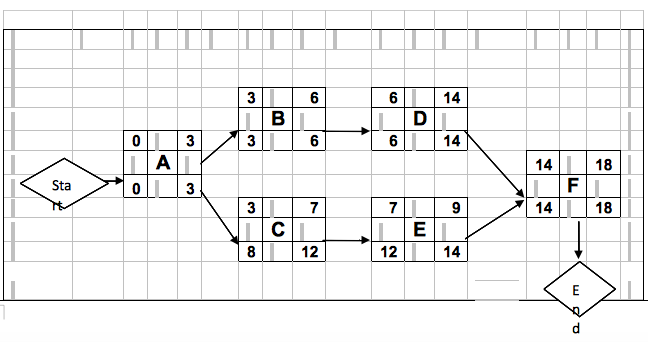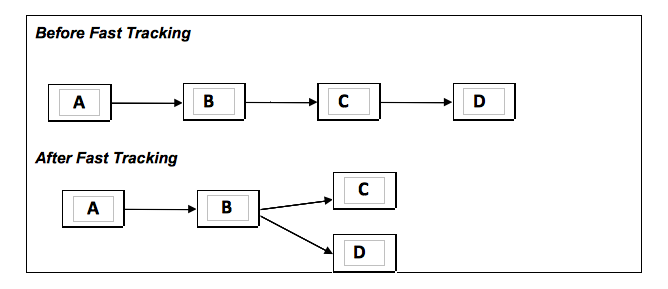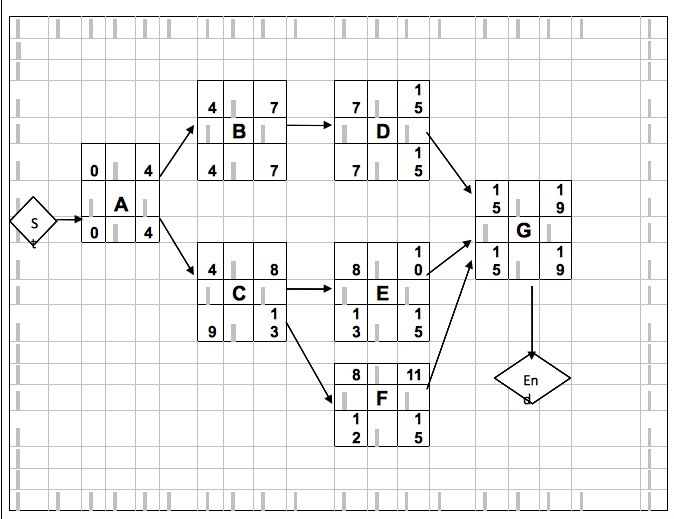Project Management Mathematics I – Planning
This article will cover the following tools and technique of Develop Schedule, out of which the last three are common tools and techniques of Control schedule.
- Critical Path Method
- Critical Chain Method
- Schedule Compression
- Resource Optimization Techniques
- Modeling Techniques
Critical Path Method
Critical path method (CPM) is a schedule method, which determines the amount of float, or schedule flexibility, for each of the network paths by calculating the earliest start date, earliest finish date, latest start date, and latest finish date for each activity. This is a schedule network technique that relies on sequential networks (one activity occurs before the next, a series of activities occurring concurrently is completed before the next series of activities begins, and so on) and on a single duration estimate for each activity. The precedence diagramming method (PDM) can be used to perform CPM. The critical path (CP) is generally the longest full path on the project. Any project activity with a float time that equals zero is considered a critical path task. The critical path can change under a few conditions. Float time is also called slack time.
There are two types of float: total float and free float.
- Total Float (TF): The total amount of time a scheduled activity may be delayed from its early start date without delaying the project finish date.
- Free float (FF): The amount of time a schedule activity can be delayed from its early start date of any immediately following schedule activities.
Calculating Float using Forward and Backward Pass
In the above figure consider the following values to calculate float
ES=3; LS=10; EF=7; LF=14
Using any of the formula of float from above
Float= LS – ES = 10 – 3 =7
Forward Pass: Early Finish=Early start date + duration of the activity.
Backward Pass: Late Start=Late Finish date – duration of the activity.
Calculating the Critical Path
A critical path task is any task that cannot be changed without impacting the project end date. By definition, these are all tasks with zero float.
Example
Create a schedule network diagram using the data given above
Critical Path is A,B,D,F as it is the longest path taking 18 daysThe float on the task A,B,D and F should be 0
But on the other path A,C,E,F
Calculate the float on task E using the formula
Float = LF – EF
= 14 – 9 = 5
Calculate the float on task C using the formula
Float = LF-EF
= 12 – 7 = 5
In the network diagram above on the non critical path A, C, E, F, you must be wondering that the EF and LF of Activity E were 9 and 14 respectively then why the ES and LS of the successor activity F are 14, and 14 respectively. The answer to this question is following forward pass we calculate the early values of all the activities first. After obtaining the Early Finish of last activity we put the Late Finish of that activity same as Early Finish, as we consider this to be on critical path (on critical path EF=LF as float is equal to 0).Once we get the Late Finish of the last activity we do the backward calculation using backward pass .That we started putting the values to Late start by subtracting the duration of that activity from Late Finish.
Critical Chain Method
Critical chain method is a schedule method that allows the project team to place buffers on project schedule path to account for limited or restricted resources. After the project schedule network diagram is constructed using duration estimates, dependencies, and constraints, resource availability is entered into the scheduling tool. The modified schedule is calculated which often changes the critical path. The new critical path showing the resource restrictions is called the critical chain. Critical chain uses both deterministic (step-by-step) and probabilistic approaches. A few steps are involved in the critical chain process:
- Construct the schedule network diagram using activity duration estimates.
- Define dependencies.
- Define constraints.
- Calculate critical path.
- Enter resource availability into the schedule.
- Recalculate for the critical chain.
These buffers are known as feeding buffers and they protect the critical chain schedule from slipping. After the buffers are added, the planned activities are then scheduled at their latest start and finish dates.
Schedule Compression
It is a form of mathematical analysis that’s used to shorten the project schedule without changing the project scope. Compression is simply shortening the project schedule to accomplish all the activities sooner than estimated.
Schedule compression might happen when the project end date has been predetermined or you discover that the project is going to take longer than the original promised date. For example, Jane, a project manager calculated the end date to be July 21. But the project was undertaken and a July 12 date was promised?
That’s when there arises a need to employ one or both of the schedule compression techniques: crashing and fast tracking.
o Crashing: This is a compression technique that looks at cost and schedule trade-offs. One of the things you might do to crash the schedule is add resources—from either inside or outside the organization—to the critical path tasks. It wouldn’t help you to add resources to noncritical path tasks; these tasks don’t impact the schedule end date anyway because they have float time. Crashing could be accomplished by requiring mandatory overtime for critical path tasks or requiring overnight deliveries of materials rather than relying on standard shipping times.
You may find that crashing the schedule can lead to increased risk and or increased costs.
o Fast Tracking: Fast tracking is performing two tasks in parallel that were previously scheduled to start sequentially. This technique can increase project risk and might cause the project team to have to rework tasks. Fast tracking will only work for activities that can be overlapped. For example, fast tracking is often performed in object-oriented programming. The programmers might begin writing code on several modules at once, out of sequential order and prior to the completion of the design phase.
However, if you remember the house-painting example, where scrapping, priming and painting were dependent task to be performed in some order. One couldn’t start priming and painting at the same time, so fast tracking is not a possibility for such activities.
In the figure below it is shown Task A, B, C, D were planned in a sequential order, but after fast tracking. Fast tracking is starting two activities previously scheduled to start one after the other at the same time
Resource Optimization Techniques
Examples of resource optimization include
- Resource Leveling: Critical path method does not consider resource availability. After determining schedule of activities and its critical path, it’s time to plug in resources for those activities and adjust the schedule according to any resource constraints discovered. Resource leveling—also called the resource-based method—is used when resources are over allocated. You’ll use this technique when they are time constrained (especially those assigned to critical path activities) or when you need to meet specific schedule dates and are concerned about resource availability. Resource estimates were identified during the Estimate Activity Resources processes. Now during Develop Schedule, resources are assigned to specific activities. Usually, you’ll find that your initial schedule has periods of time with more activities than you have resources to work on them. You will also find that it isn’t always possible to assign 100 percent of your team members’ time to tasks. Sometimes your schedule will show a team member who is over allocated, meaning they’re assigned to more work than they can physically perform in the given time period. At the same time, there are resources only 50 percent allocated .Such resources that are under allocated can be assigned to multiple tasks to keep them busy.
- Resource Smoothing: It is a technique that adjusts the activities of a schedule model such that the requirements for resources on the project do not exceed certain predefined limits. In resource smoothing, as opposed to resource leveling, the project’s critical path is not changed and the completion date may not be delayed. Activities may only be delayed within their free and total float. Thus resource smoothing may not be able to optimize all resources
Modeling Techniques
Examples of modeling techniques include
- What-If Scenario Analysis: It analysis uses different sets of activity assumptions to produce multiple project durations. For example, what would happen if a major deliverable was delayed or due to some unknown risk, it cannot be completed on time? What-if analysis weighs these questions and their assumptions and determines the feasibility of the project schedule under these conditions.
- Simulation: This technique involves calculating multiple project durations with different sets of activity. The most common simulation techniques is Monte Carlo analysis .It use a range of probable activity durations for each activity, and those ranges are then used to calculate a range of probable duration results for the project itself. Monte Carlo runs the possible activity durations and schedule projections many, many times to come up with the schedule projections and their probability, critical path duration estimates, and float time.
Questions & Answers
- You’re the project manager and developing the project schedule for an undertaking. Looking at the following graph, which path is the critical path?
- A. A-B-D-G
- B. A-C-E-G
- C. A-C-F-G
- D. A-B-C-F-G
Correct Answer: A. The only information you have for this example is activity dates, so you must calculate the critical path based on the early and late values. The duration of A-B-D-G is 19. The duration of A-C-E-G and A-C-F-G are 14 and 15 respectively. As the longest duration is 19 and so the critical path is A-B-D-G.
- Find the float of the activity F in the figure above
- A. 0
- B. 4
- C. 5
- D. 10
Correct Answer: B. Float = LF – EF = 15 – 11= 4
- Which of the following compression techniques increases risk?
- A. Crashing
- B. Resource leveling
- C. Fast tracking
- D. Lead and lag
Correct Answer: C. Fast tracking is a compression technique that increases risk and potentially causes rework. Fast tracking is starting two activities previously scheduled to start one after the other at the same time.
- Feeding buffers and the project buffer are part of which of the following Develop Schedule tool and technique?
- A. Critical path method
- B. Schedule network analysis
- C. Applying leads and lags
- D. Critical chain method
Correct Answer: D. Critical chain method.
Take a Free Demo of Whizlabs PMP Offerings:
PMP Exam Questions
PMP Online Training (with full length videos)
PMP Live Virtual Classroom Training
<span>Preparing for PMP® Certification? Pass in 1st attempt through<a href=”https://www.whizlabs.com/project-management-professional-pmp/”> Whizlabs PMP Training Course!</a> Start with Free Trial!</span>
- What are Scrum roles and why it’s needed? - August 12, 2017
- Stakeholder Analysis – Is it required? - July 28, 2017
- Project Manager – An integrator, how? - July 28, 2017
- Different PMI Certifications – Which one to choose? - July 28, 2017
- What is the importance of Change Management in Project Management? - June 23, 2017
- What’s important to know to build a career in Agile? - June 23, 2017
- Agile Basics, Manifesto & Principles - June 23, 2017
- Scrum – Is it mandatory to learn in today’s IT market? - June 2, 2017




